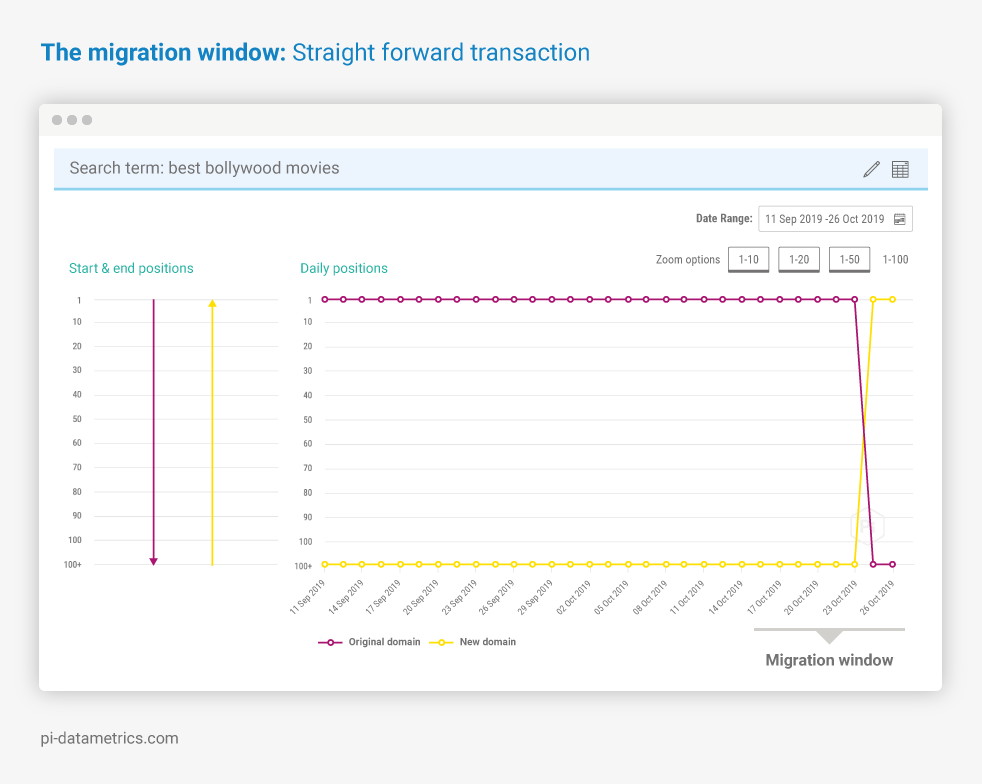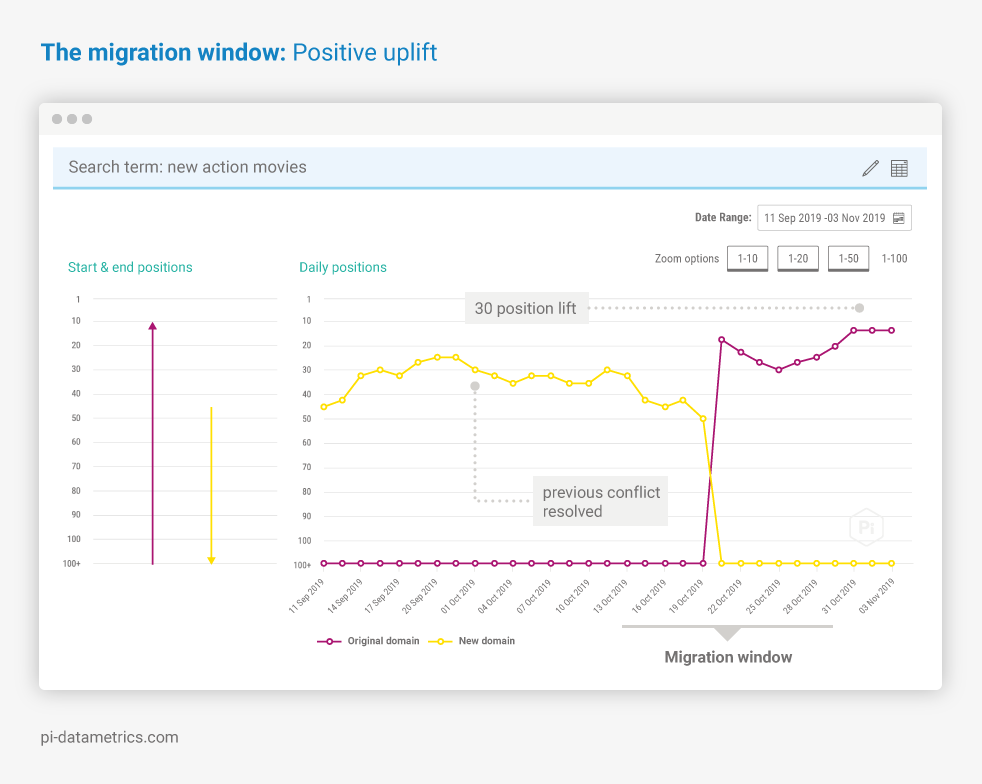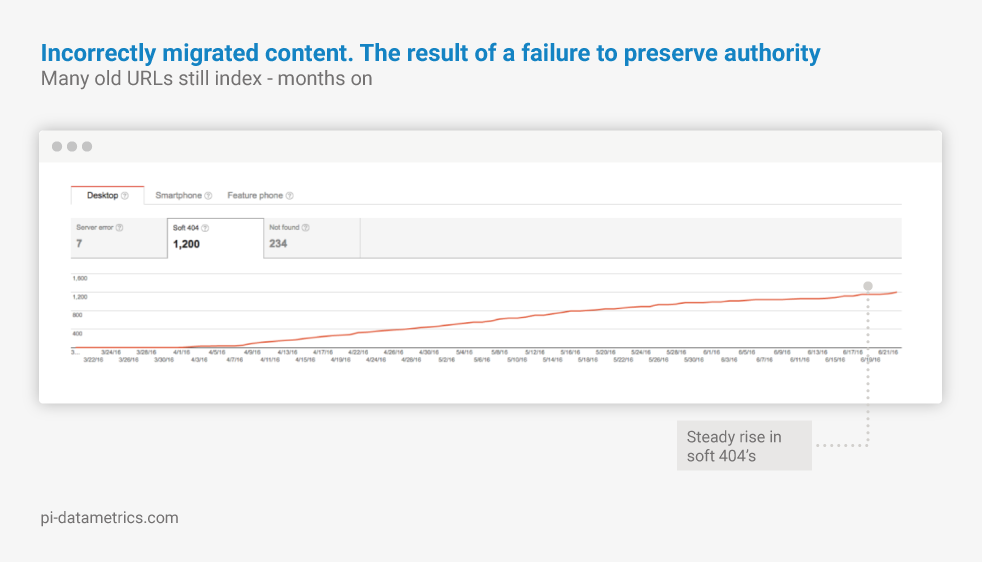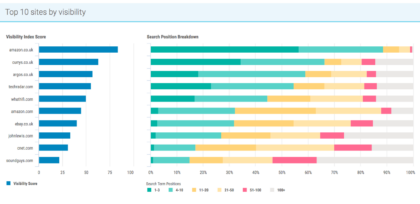Website Migration: A 5 step guide to success
02 Mar 2020|7 MIN READ
Despite popular belief, website migrations can present you with greater search presence and ROI opportunity, when executed correctly.
From an SEO perspective, if a URL change affects all pages on a website, this is deemed a migration.
There are some migrations which don’t impact on SEO. For example, in some instances changing the underlying technology, such as the CMS, may not necessarily have any impact on your content or URLs.
Will my rankings suffer?
At Pi, we don’t believe that losing rankings is inevitable – providing you have the right planning. You may see a drop in the first few days, but then you should see your site regain, if not surpass, your previous rankings.
What are the different types of website migration?
Subdomain to subfolder: Subdomains don’t benefit at all from backlinks to the root domain like subfolders do. Google sees them as separate sites. They also tend to be harder to manage and are often separated across different CMS’s, and are more likely to suffer from subdomain conflict. As a result, some companies decide to re-organise their content into a subfolder formation.
Domain name change: any change to your domain name would mean a change to every page of your site. We’re talking a name change, brand refresh, or shifting focus to a sister site. These are all valid reasons for conducting a site migration.
Hosting: Whether you’re switching site hosts to increase data storage or improve browser security, site migrations can give you a great opportunity to boost performance. You’ll need to come up with a cohesive redirect strategy as you’ll be changing your Domain Name Server (DNS) to point to a new IP address – even if the domain name itself stays the same.
Architecture: You may be looking to improve UX and the paths to conversion through a website rebuild and site migration.
HTTP to HTTPS: It’s been widely reported that running over HTTPS is better for security, performance, SEO rankings (HTTPS is defined as a lightweight ranking signal), referral data and so on – so it’s no surprise that more and more companies are looking to migrate from HTTP to HTTPS. A common error dev teams tend to make in this context is to forget about updating internal links.
Site structure changes: Overhauling your site’s architecture can affect your internal linking and even your URL structure. Site structure changes are by far the most challenging migrations and are most likely to cause drops. They have the biggest impact on rankings, be it negative or positive, because you are changing so many ‘things’ that are viewed, by Google, as ranking factors.
Changing CMS: If you need to fix tech issues and bugs, enhance functionality or improve security, then you may be in the market for a new CMS, which often requires a site migration. Moving your current site either from your previous CMS, or moving over a hard coded site is an example of a pretty tricky migration. For example, changing from a hard coded website to a CMS is often beneficial, as custom-built sites require a huge amount of knowledge in order to make any small change. However, some CMS migrations can have absolutely no impact on content and don’t require any redirects.
Content audits: changing, updating, consolidating your SEO content at scale can have a huge impact on your site’s rankings. Navigation can change, and internal links may be broken.
Site redesign: This can range from a complete redesign to making smaller aesthetic adjustments to parts of your site.
What could go wrong with a website migration?
When SEO isn’t a consideration…
A huge pitfall for website migrations are if organic traffic and SEO are not considered from the beginning.
Optimising your website and content for search engines is so important when migrating.
Why is it that we’re often quite happy to undertake migrations without that TRAINING, ADVICE or PREPARATION?
Why do we leave it to the IT team to sort it out?
And why do we scrimp on the website migration budget?
Pumping time, effort and capital into design alone is a sure-fire way to end up buried at the bottom of the search engines.
You can experience a huge increase in 404s (broken links)…
As a result of neglecting SEO, you could incur broken links and 404s, both of which impact user experience. If 404s keep being thrown up as a user navigates your site, they won’t stick around. Search engines don’t like this either; Google crawls your site less frequently if it hits a large amount of 404s, and reduced crawling can result in ranking loss.
Search engines can ignore your site…
If your URLs change and you haven’t properly signposted to Google where your content has gone, when it crawls your site it may even decide you no longer exist! This will obviously lose you a huge amount of traffic.
Why should you risk doing a website migration?
Despite popular belief, site migrations can present you with greater search presence and ROI opportunity.
Organic search is the number 1 traffic driver, so you need to be thinking about SEO at each step of your site migration. Get this right, and you’ll maintain, if not surpass, your pre-migration ranking.
How long does a website migration take?
The actual migrating of the website itself depends on the amount of data transferred, the site’s size and the overall complexity of the structure. Despite this, most migrations don’t surpass the three hour mark, and usually take up to 30 minutes.
However, the time it takes for a website’s visibility to return to ‘normal’, is a lot longer than this.
Some would have you believe that your site can never achieve the rankings it once had pre-migration. In fact, those same people will tell you the ‘Old migratory myth’: to expect a 20% drop in traffic afterwards! At Pi we know that’s simply not true. With the right data and knowledge at your fingertips, you can not just return to your previous rankings, but boost them!
The Migratory Window
We refer to the seven to 28 days following a website migration as the ‘Migratory window’. After this time, your site’s search engine rankings should have returned to equilibrium. Therefore, daily tracking of all URLs involved in the website migration is crucial to its success.
During this time, you may see a variety of different outcomes in the SERPs:
- Changeover: The overall changeover may take some time to kick-in, following the migration
- Arbitrary drops: Random, site-wide drops in ranking can occur

- Brief coexistence: There may be a brief coexistence between the old domain and the new one for a short time

- Straightforward transition: Website rankings may remain the same, both before and after the migration

- Positive uplift: Website ranking performance may improve post-migration (e.g. if internal conflict is resolved through an appropriate landing page/canonical tag strategy)
Get more depth, analysis and faster speed to insight with Pi
Get startedWhat are the 5 steps for a successful SEO migration?
At Pi, we see migrations as a great opportunity to evaluate architecture, improve performance and overtake competitors.
Here are the key things to get right:
1. Involve SEO from the start
- SEO should be the cornerstone of any website migration strategy. Without it, you may as well be throwing your hard earned positions and revenue down the drain.
- Set project resources and scope very, very early on – Once the ball is rolling it can be very difficult to bring the SEO team in. They may have to veto certain decisions that were made long ago. They also have requirements to fulfil their deliverables, and if they’re not provided at the right time you could be facing a migration delay!
- Involve SEO in scoping and plan to build SEO in at all appropriate touch points.
- Seek the help of a person experienced in migrations.
- Allow the SEO team to build relationships and establish credibility within the migration team.
2. Consolidate your redirects and mapping
- It’s essential that you crawl every page of your site – map-out the titles, the H1s, the meta-descriptions and really get a feel for your site. You can then use this insight to dictate your new site structure.
- Check for old subdomains and orphan pages.
- Create a detailed redirect map with old and new URLs.
- Every page matters – especially the priority ones.
- If you’re in pre-build phase – review the theming and internal linking.
- Record external backlinks – especially those that generate valuable referral traffic.
- Test thoroughly in staging and after launch.
Not crawling your site efficiently can result in a rise in soft 404s.

This is a multi-billion pound company which will have lost millions of pounds as a result of:
- Pages still being indexed in the SERPs post-migration
- Highly inappropriate redirects
- A substantial number of pages 302 redirecting to the homepage
This could have been avoided if this company had only audited its site to determine appropriate redirects. Regaining authority following these 404s will take a long time.
3. Use visibility data
Your visibility data holds everything together and acts as damage limitation during your site migration. You should, therefore, use it to:
- Benchmark visibility performance pre-migration.
- Record rankings and traffic from start to finish.
- Look for opportunities to improve ranking. For example, define pages which are currently returning below the fold on page one, and optimise them as you migrate.
- Determine the current extent of conflict. For example, if there’s conflict between a group of URLs, fix it before migrating.
- Determine which competitors are performing better, and why.
- Find/modify existing redirects to avoid chains.
- Use daily data! Monitor the migratory window with daily SEO tracking – you can’t afford to wait a week for that report! A SEO platform like Pi can offer this type of granular tracking, to help you immediately identify any performance issues during the website migration process.
4. Make sure there’s a project owner
Without a clear line of authority to reaffirm the importance of the other 4 steps, a migration will go off-track, resulting in that dreaded drop.
- Give one person responsibility and authority to run the migration.
- Involve them throughout the project to ensure they grasp the architecture and the quirks of the site.
- Empower them to make and enforce decisions.
5. Prevent the staging site from being revealed
Your stage site is an exact duplicate of your live site post-migration, and is therefore very likely to conflict with it, if let loose in the search engines. It’s vital that the pre-live site is kept under wraps!
Remember that robots.txt only blocks crawling, NOT indexing – don’t accidentally release your pre-live stage site!
Did you know?
Even if a stage URL is shared privately in Gmail, Google may well still index the site via this medium. This is based on what we’ve seen at Pi previously with our own clients.
Here’s some tips to avoid leaking your stage site:
– Use IP whitelisting
– Make logging in a requirement
– Add noindex tags to the <head> of each page
SEO should be the cornerstone of any website migration
SEO is not the icing on the cake – it’s a key ingredient. You can’t just “SEO” your migration retrospectively – the damage will already have been done to your visibility!
Don’t always believe the ‘Old migratory myth’ and don’t accept that you will incur a loss in traffic before you’ve already begun!
See your website migration as an opportunity, optimise throughout and utilise data before, during and after, to achieve the best results.
Demo the Pi Platform
Never miss a post
Join our mailing list and have our SEO news delivered straight to your inbox.




